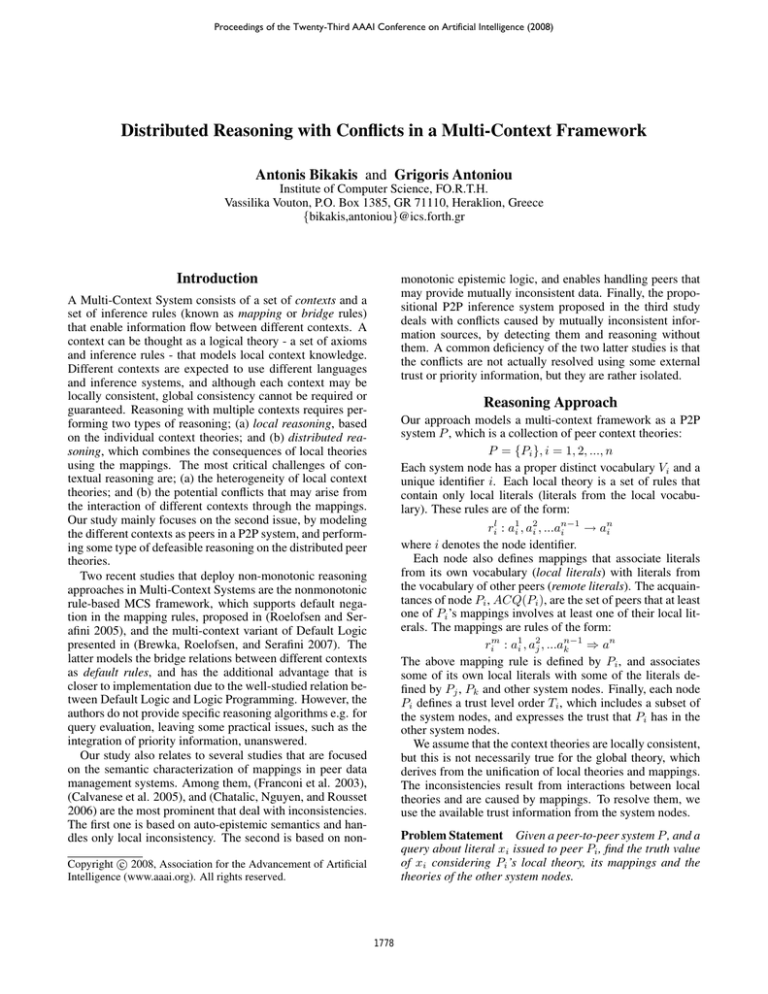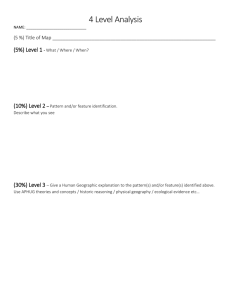
Proceedings of the Twenty-Third AAAI Conference on Artificial Intelligence (2008)
Distributed Reasoning with Conflicts in a Multi-Context Framework
Antonis Bikakis and Grigoris Antoniou
Institute of Computer Science, FO.R.T.H.
Vassilika Vouton, P.O. Box 1385, GR 71110, Heraklion, Greece
{bikakis,antoniou}@ics.forth.gr
Introduction
monotonic epistemic logic, and enables handling peers that
may provide mutually inconsistent data. Finally, the propositional P2P inference system proposed in the third study
deals with conflicts caused by mutually inconsistent information sources, by detecting them and reasoning without
them. A common deficiency of the two latter studies is that
the conflicts are not actually resolved using some external
trust or priority information, but they are rather isolated.
A Multi-Context System consists of a set of contexts and a
set of inference rules (known as mapping or bridge rules)
that enable information flow between different contexts. A
context can be thought as a logical theory - a set of axioms
and inference rules - that models local context knowledge.
Different contexts are expected to use different languages
and inference systems, and although each context may be
locally consistent, global consistency cannot be required or
guaranteed. Reasoning with multiple contexts requires performing two types of reasoning; (a) local reasoning, based
on the individual context theories; and (b) distributed reasoning, which combines the consequences of local theories
using the mappings. The most critical challenges of contextual reasoning are; (a) the heterogeneity of local context
theories; and (b) the potential conflicts that may arise from
the interaction of different contexts through the mappings.
Our study mainly focuses on the second issue, by modeling
the different contexts as peers in a P2P system, and performing some type of defeasible reasoning on the distributed peer
theories.
Two recent studies that deploy non-monotonic reasoning
approaches in Multi-Context Systems are the nonmonotonic
rule-based MCS framework, which supports default negation in the mapping rules, proposed in (Roelofsen and Serafini 2005), and the multi-context variant of Default Logic
presented in (Brewka, Roelofsen, and Serafini 2007). The
latter models the bridge relations between different contexts
as default rules, and has the additional advantage that is
closer to implementation due to the well-studied relation between Default Logic and Logic Programming. However, the
authors do not provide specific reasoning algorithms e.g. for
query evaluation, leaving some practical issues, such as the
integration of priority information, unanswered.
Our study also relates to several studies that are focused
on the semantic characterization of mappings in peer data
management systems. Among them, (Franconi et al. 2003),
(Calvanese et al. 2005), and (Chatalic, Nguyen, and Rousset
2006) are the most prominent that deal with inconsistencies.
The first one is based on auto-epistemic semantics and handles only local inconsistency. The second is based on non-
Reasoning Approach
Our approach models a multi-context framework as a P2P
system P , which is a collection of peer context theories:
P = {Pi }, i = 1, 2, ..., n
Each system node has a proper distinct vocabulary Vi and a
unique identifier i. Each local theory is a set of rules that
contain only local literals (literals from the local vocabulary). These rules are of the form:
ril : a1i , a2i , ...an−1
→ ani
i
where i denotes the node identifier.
Each node also defines mappings that associate literals
from its own vocabulary (local literals) with literals from
the vocabulary of other peers (remote literals). The acquaintances of node Pi , ACQ(Pi ), are the set of peers that at least
one of Pi ’s mappings involves at least one of their local literals. The mappings are rules of the form:
rim : a1i , a2j , ...an−1
⇒ an
k
The above mapping rule is defined by Pi , and associates
some of its own local literals with some of the literals defined by Pj , Pk and other system nodes. Finally, each node
Pi defines a trust level order Ti , which includes a subset of
the system nodes, and expresses the trust that Pi has in the
other system nodes.
We assume that the context theories are locally consistent,
but this is not necessarily true for the global theory, which
derives from the unification of local theories and mappings.
The inconsistencies result from interactions between local
theories and are caused by mappings. To resolve them, we
use the available trust information from the system nodes.
Problem Statement Given a peer-to-peer system P , and a
query about literal xi issued to peer Pi , find the truth value
of xi considering Pi ’s local theory, its mappings and the
theories of the other system nodes.
c 2008, Association for the Advancement of Artificial
Copyright °
Intelligence (www.aaai.org). All rights reserved.
1778
P1
l
r11
: a1 → x1
m
r12
: b1 ⇒ a1
m
r13
: b2 ⇒ b1
P2
l
r21
l
r22
m
r23
m
r24
P4
l
r41
: e4 → b 4
m
r42
: e6 ⇒ e4
P5
l
r51
:→ d5
: c2 → b2
: d2 → b2
: b3 , b4 ⇒ ¬b2
: d5 ⇒ d2
P3
l
r31
:→ b3
answer for x1 .
Some interesting properties of P 2P DR are:
• Termination. The algorithm is guaranteed to terminate
returning either a positive or a negative answer for the
queried literal (due to cycle detection).
• Number of Messages. With the addition of two states,
which keep track of the incoming and outgoing queries
of each system node, we can reduce the total number of
messages that are exchanged between the system nodes
for the computation of a single query to O(n2 ) (in the
worst case that all nodes have defined mappings with all
the other system nodes), where n stands for total number
of system nodes.
• Single Node Complexity The computational complexity
of the algorithm on a single node is in the worst case
O(n2 ×n2l ×nr ), where nl stands for the number of literals
a node may define, and nr stands for the total number of
(local and mapping) rules that a peer theory may contain.
• Equivalent Unified Defeasible Theory. Using a standard process, it is possible to unify the local context theories into a global defeasible theory, which produces the
same results. In this theory, local rules are modeled as
strict rules, mappings are modeled as defeasible rules, and
trust information from the system nodes is used to derive
priorities between conflicting rules.
P6
l
r61
:→ b6
Figure 1: A MCS System of Six Context Theories
The P 2P DR Algorithm The algorithm follows four
main steps. The first one involves checking if the queried
literal (xi ), or its negation (¬xi ) are local consequences of
Pi ’s local theory. If not, the algorithm collects, in the second step, the local and mapping rules that support xi . For
each such rule, it checks the truth value of the literals in its
body, by issuing similar queries (recursive calls of the algorithm) to Pi or to the appropriate neighboring nodes. To
avoid circles, before each new call, the algorithm checks if
the same query has been issued before, during the same algorithm call. In the end of this step, the algorithm builds
the mapping supportive set of xi ; this contains the set of foreign literals (literals that are defined by peers that belong in
ACQ(Pi )) that are contained in the body of those Pi ’s mapping rules, which can be applied to prove xi in the absence
of any contradictions. In the third step, in the same way with
the second step, the algorithm collects the rules that contradict xi and builds the conflicting set of xi . In the last step,
the algorithm determines the truth value of xi by comparing
the supportive and conflicting sets. To compare two mapping sets, a peer Pi uses its trust level order, Ti . According
to this, a literal ak is considered to be stronger than bl from
Pi ’s viewpoint Pk precedes Pl in Ti . Below, we demonstrate
how the algorithm works through the example depicted in
Figure 1. A more detailed description of the algorithm is
available at http://www.csd.uoc.gr/∼bikakis/P2PDR.pdf.
In the MCS system depicted in Figure 1, consider that a
query about x1 is issued to P1 . Neither x1 nor ¬x1 derive
from P1 ’s local theory, so the algorithm proceeds to the secl
m
l
, r12
and r13
, and
ond step. It successively calls rules r11
issues a query about b2 to P2 . In P2 , two rules support b2 ;
l
l
l
. c2 , which is the only premise of r21
, is not
and r22
r21
l
supported by any rule, so r21
is not applicable. To check
l
can be applied, the algorithm successively calls
if rule r22
m
r24 and issues a query about d5 to P5 . d5 is locally proved,
so P5 returns a positive answer for d5 . The algorithm, then,
constructs the supportive set for b2 , which contains literal
d5 (SSb2 = {d5 }). The next step is to check the only rule
m
that contradicts b2 , rule r23
. Using a similar process, the algorithm ends up with a conflicting set that contains literals
b3 and b4 (CSb2 = {b3 , b4 }). To compare SSb2 and CSb2
, the algorithm uses the trust level order defined by P2 , T2 .
Assuming that P3 precedes P5 and P5 precedes P4 in T2 ,
d5 and b4 are respectively the weakest elements of SSb2 and
CSb2 , and d4 is weaker than d5 . Consequently, P2 returns a
positive answer for b2 , and P1 eventually returns a positive
Planned Future Work
Part of our ongoing work is to extend the algorithm to support defeasible local theories, overlapping vocabularies and
non-Boolean queries. We also study alternative versions of
the main algorithm, which differ in the way that a node
evaluates the answers returned by its peers; for example we
could associate the quality of an answer not only with the
trust level of the queried peer, but also with the confidence
of the queried peer on the answer it returns. Finally, we plan
to study applications of our approach in the Ambient Intelligence and Semantic Web domains, where the theories may
represent ontological context knowledge (Horn logic subset
of OWL DL), policies and regulations.
References
Brewka, G.; Roelofsen, F.; and Serafini, L. 2007. Contextual Default Reasoning. In IJCAI, 268–273.
Calvanese, D.; De Giacomo, G.; Lembo, D.; Lenzerini, M.;
and Rosati, R. 2005. Inconsistency Tolerance in P2P Data
Integration: an Epistemic Logic Approach. In DBPL-05,
volume 3774 of LNCS, 90–105. SV.
Chatalic, P.; Nguyen, G. H.; and Rousset, M.-C. 2006.
Reasoning with Inconsistencies in Propositional Peer-toPeer Inference Systems. In ECAI, 352–356.
Franconi, E.; Kuper, G. M.; Lopatenko, A.; and Serafini,
L. 2003. A Robust Logical and Computational Characterisation of Peer-to-Peer Database Systems. In DBISP2P,
64–76.
Roelofsen, F., and Serafini, L. 2005. Minimal and Absent
Information in Contexts. In IJCAI, 558–563.
1779






